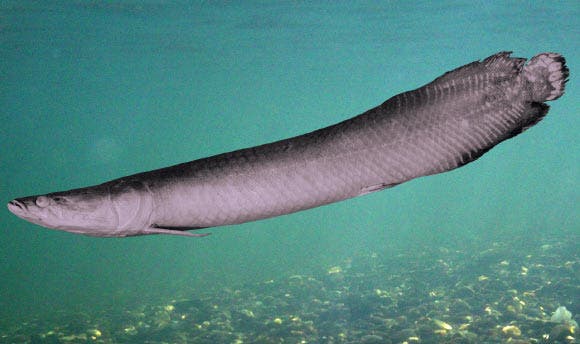
Large megafish like these have become rare worldwide due to heavy fishing. The arapaima is the focus of several conservation projects in South America, including no-fishing reserves and fishing quotas.
(c) Zeb Hogan
Also known as the paiche or the pirarucu, the arapaima is one of the most fascinating species of fish in the world. It’s one of the largest freshwater fish in the world, and certainly the biggest in South America, being a native to the Amazon Basin and nearby lakes and swamps. These arapaima are absolutely huge, most spanning 2.5 meters in length and weighing up to 200 kg, but some may grow even bigger. Besides its size, though, the arapaima immediately stands out through another feature: it can breath air.
Though arapaimas can stay underwater for 10 to 20 minutes, they tend to remain near the water’s surface, where they hunt and emerge often to breathe with a distinctive coughing noise. They survive mainly on fish but are known to occasionally grab birds close to the water’s surface. Because they stay so close to the water surface, this also makes them particularly vulnerable to fishing. Today, arapaima are rarely seen in the Amazon basin and conservation efforts are made to protect this giant fish.
Recently, biologists have described a new species of arapaima: the Arapaima leptosoma, is the first new species to be described since 1847. Its name is derived from the Greek leptos (slender) and soma(body), in reference to the relatively slender body form of this species. Like its cousins, the Arapaima l. can also grow very large, and aside from its slender form it also presents some other specific characteristics.

According to professor Donald Steward, who led the team of researchers who described the Arapaima l. in a paper published in the journal Copeia: the new species is “distinguished from all other Arapaima by following three characters: dorsalmost lateralis sensory cavity on preopercle extremely slender; ventrolateral margin of head where third infraorbital meets anterior limb of preopercle strongly angled such that ventral surface of head is almost flat; and anterior third of dorsal-fin base covered with an enlarged, thickened sheath that hides anterior dorsal-fin rays when adpressed.”
So far, only one specimen of Arapaima l. has been found. A lone fish caught in 2001 near the confluence of the Solimões and Purus rivers in Amazonas State, Brazil.
[ALSO READ] Did you know there’s a fish that has human teeth? The sheepshead fish is one of a kind
“Collecting adult Arapaima involves considerable difficulties, both with logistics in the field and subsequent storage in museums,” Prof Stewart wrote in the paper.
“As this study demonstrates, however, collecting at least a few voucher specimens can greatly enhance our knowledge of these fascinating fishes. Many more are needed.”
“Arapaima have high economic, cultural, and scientific value, but their diversity has been overlooked for too long,” the scientist concluded.


